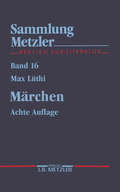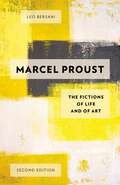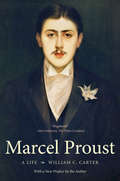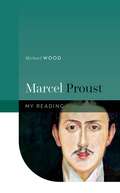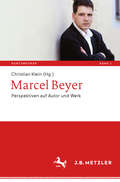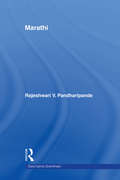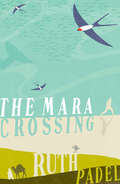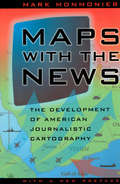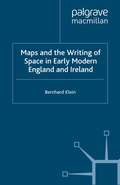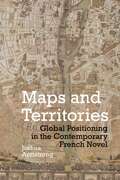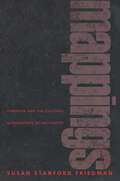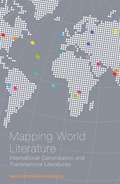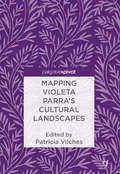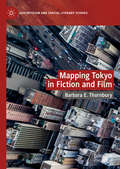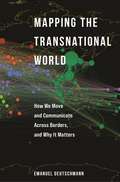- Table View
- List View
Marcel Proust: The Fictions of Life and of Art
by Leo BersaniOxford University Press published eminent literary critic Leo Bersani's first book, on Proust, in 1965, but the work has long been out of print. This new edition comes in response to a recent renewal of interest among philosophers of literature, among others, and features a new preface from the author.
Marcel Proust: A Life, with a New Preface by the Author (Henry McBride Series in Modernism and Modernity)
by William C. CarterReissued with a new preface to commemorate the first publication of À la recherche du temps perdu one hundred years ago, Marcel Proust portrays in abundant detail the extraordinary life and times of one of the greatest literary voices of the twentieth century. “An impeccably researched and well-paced narrative that brings vividly and credibly to life not only the writer himself but also the changing world he knew.”—Roger Pearson, New York Times Book Review “William C. Carter is Proust’s definitive biographer.”—Harold Bloom Named a Notable Book of 2000 by the New York Times Book Review
Marcel Proust (My Reading)
by Michael WoodA witty, refreshing, and fun book on the experience of reading Marcel Proust. What would the world be like without this work, where would we be if it hadn't happened? This is how Michael Wood found himself writing about Proust's work as an event and about events in relation to that work itself. The event that created the figure we know as Proust did not take a whole lifetime, we can date it to within certain months, perhaps certain weeks, of a certain year, 1908. That was when Proust the interesting occasional writer and full-time socialite, turned into an ostensible hermit and a real novelist. This short book says something about the event as a lifetime affair, and shows what the sudden change of 1908 looks like. It explores the work of Marcel Proust as an event in the world, something that happened to literature and culture and our understanding of history. This event has more aspects than we can count, but this book offers detailed critical snapshots of seven of them: the birth of Proust as a novelist; what he teaches us about the mythology of beginnings; about metaphor as a kind of rebellion; about love as a permanent anxiety attack; about the Dreyfus Affair; about the concept of justice; about the mythology of endings.
Marcel Proust (My Reading)
by Michael WoodA witty, refreshing, and fun book on the experience of reading Marcel Proust. What would the world be like without this work, where would we be if it hadn't happened? This is how Michael Wood found himself writing about Proust's work as an event and about events in relation to that work itself. The event that created the figure we know as Proust did not take a whole lifetime, we can date it to within certain months, perhaps certain weeks, of a certain year, 1908. That was when Proust the interesting occasional writer and full-time socialite, turned into an ostensible hermit and a real novelist. This short book says something about the event as a lifetime affair, and shows what the sudden change of 1908 looks like. It explores the work of Marcel Proust as an event in the world, something that happened to literature and culture and our understanding of history. This event has more aspects than we can count, but this book offers detailed critical snapshots of seven of them: the birth of Proust as a novelist; what he teaches us about the mythology of beginnings; about metaphor as a kind of rebellion; about love as a permanent anxiety attack; about the Dreyfus Affair; about the concept of justice; about the mythology of endings.
Marcel Beyer: Perspektiven auf Autor und Werk (Kontemporär. Schriften zur deutschsprachigen Gegenwartsliteratur #1)
by Christian KleinDie Stimme Marcel Beyers zählt zu den wichtigsten in der deutschsprachigen Gegenwartsliteratur. Der Band unternimmt erstmals eine systematische Auseinandersetzung mit diesem ebenso ergiebigen wie qualitativ herausragenden Œuvre. Ausgewiesene Expertinnen und Experten widmen sich in vierzehn Einzelbeiträgen Beyers Lyrik und seinen Romanen, rücken bisher eher vernachlässigte Textgruppen (Essays, Libretti) in den Blick und diskutieren Beyers Poetik sowie die Rezeption seiner Texte. Damit ist der Band gleichermaßen als Einführung in das Werk Marcel Beyers wie für die vertiefende Auseinandersetzung mit einzelnen seiner Texte geeignet. Er ermöglicht einen Werküberblick, stellt gattungsübergreifend zentrale Themen sowie literarische Verfahren vor und setzt gleichzeitig neue Forschungsimpulse. Abgerundet wird der Band durch einen Originaltext Beyers sowie ein ausführliches Werkstattgespräch.
Marathi (Descriptive Grammars)
by Rajeshwari V. PandharipandeThis is a complete grammatical description of Marathi, which belongs to the Indo-European family and is spoken in Maharashtra State in India. It has around 45 million speakers, who comprise about eight per cent of the total population of India. Marathi is particularly interesting from the point of view of its structure: it is a blending of linguistic features of the Indo-European and Dravidian language families. Marathi provides fascinating data for the study of language typology, structural change, and language universals.
Marathi (Descriptive Grammars)
by Rajeshwari V. PandharipandeThis is a complete grammatical description of Marathi, which belongs to the Indo-European family and is spoken in Maharashtra State in India. It has around 45 million speakers, who comprise about eight per cent of the total population of India. Marathi is particularly interesting from the point of view of its structure: it is a blending of linguistic features of the Indo-European and Dravidian language families. Marathi provides fascinating data for the study of language typology, structural change, and language universals.
The Mara Crossing
by Ruth PadelHome is where you start from, but where is a swallow's real home? And what does 'native' mean if the English oak is an immigrant from Spain?In ninety richly varied poems and illuminating prose interludes, Ruth Padel's original new book weaves science, myth, wild nature and human history to conjure a world created and sustained by migration. 'We're all from somewhere else,' she begins, tracing the millennia-old journeys of cells, trees, birds and beasts. Geese battle raging winds over Mount Everest, lemurs skim precipices in Madagascar and wildebeest, at the climax of their epic trek from Tanzania, brave a river filled with the largest, hungriest crocodiles in Africa. Human migration has shaped civilisation but today is one of the greatest challenges the world faces. In a series of incisive portraits, Padel turns to the struggles of human displacement - the Flight into Egypt, John James Audubon emigrating to America (feeding migrant birds en route), migrant workers in Mumbai and refugees labouring over a drastically changing planet - to show how the purpose of migration, for both humans and animals, is survival.Poignant, thought-provoking and utterly compelling, here is a magnificent tapestry of life on the move from the acclaimed author of Darwin: A Life in Poems.
Maps with the News: The Development of American Journalistic Cartography
by Mark MonmonierMaps with the News is a lively assessment of the role of cartography in American journalism. Tracing the use of maps in American news reporting from the eighteenth century to the 1980s, Mark Monmonier explores why and how journalistic maps have achieved such importance. "A most welcome and thorough investigation of a neglected aspect of both the history of cartography and modern cartographic practice."—Mapline "A well-written, scholarly treatment of journalistic cartography. . . . It is well researched, thoroughly indexed and referenced . . . amply illustrated."—Judith A. Tyner, Imago Mundi "There is little doubt that Maps with the News should be part of the training and on the desks of all those concerned with producing maps for mass consumption, and also on the bookshelves of all journalists, graphic artists, historians of cartography, and geographic educators."—W. G. V. Balchin, Geographical Journal "A definitive work on journalistic cartography."—Virginia Chipperfield, Society of University Cartographers Bulletin
Maps with the News: The Development of American Journalistic Cartography
by Mark MonmonierMaps with the News is a lively assessment of the role of cartography in American journalism. Tracing the use of maps in American news reporting from the eighteenth century to the 1980s, Mark Monmonier explores why and how journalistic maps have achieved such importance. "A most welcome and thorough investigation of a neglected aspect of both the history of cartography and modern cartographic practice."—Mapline "A well-written, scholarly treatment of journalistic cartography. . . . It is well researched, thoroughly indexed and referenced . . . amply illustrated."—Judith A. Tyner, Imago Mundi "There is little doubt that Maps with the News should be part of the training and on the desks of all those concerned with producing maps for mass consumption, and also on the bookshelves of all journalists, graphic artists, historians of cartography, and geographic educators."—W. G. V. Balchin, Geographical Journal "A definitive work on journalistic cartography."—Virginia Chipperfield, Society of University Cartographers Bulletin
Maps with the News: The Development of American Journalistic Cartography (John D. And Catherine T. Macarthur Foundation Series On Mental Health And Development)
by Mark MonmonierMaps with the News is a lively assessment of the role of cartography in American journalism. Tracing the use of maps in American news reporting from the eighteenth century to the 1980s, Mark Monmonier explores why and how journalistic maps have achieved such importance. "A most welcome and thorough investigation of a neglected aspect of both the history of cartography and modern cartographic practice."—Mapline "A well-written, scholarly treatment of journalistic cartography. . . . It is well researched, thoroughly indexed and referenced . . . amply illustrated."—Judith A. Tyner, Imago Mundi "There is little doubt that Maps with the News should be part of the training and on the desks of all those concerned with producing maps for mass consumption, and also on the bookshelves of all journalists, graphic artists, historians of cartography, and geographic educators."—W. G. V. Balchin, Geographical Journal "A definitive work on journalistic cartography."—Virginia Chipperfield, Society of University Cartographers Bulletin
Maps with the News: The Development of American Journalistic Cartography (John D. And Catherine T. Macarthur Foundation Series On Mental Health And Development)
by Mark MonmonierMaps with the News is a lively assessment of the role of cartography in American journalism. Tracing the use of maps in American news reporting from the eighteenth century to the 1980s, Mark Monmonier explores why and how journalistic maps have achieved such importance. "A most welcome and thorough investigation of a neglected aspect of both the history of cartography and modern cartographic practice."—Mapline "A well-written, scholarly treatment of journalistic cartography. . . . It is well researched, thoroughly indexed and referenced . . . amply illustrated."—Judith A. Tyner, Imago Mundi "There is little doubt that Maps with the News should be part of the training and on the desks of all those concerned with producing maps for mass consumption, and also on the bookshelves of all journalists, graphic artists, historians of cartography, and geographic educators."—W. G. V. Balchin, Geographical Journal "A definitive work on journalistic cartography."—Virginia Chipperfield, Society of University Cartographers Bulletin
Maps with the News: The Development of American Journalistic Cartography (John D. And Catherine T. Macarthur Foundation Series On Mental Health And Development)
by Mark MonmonierMaps with the News is a lively assessment of the role of cartography in American journalism. Tracing the use of maps in American news reporting from the eighteenth century to the 1980s, Mark Monmonier explores why and how journalistic maps have achieved such importance. "A most welcome and thorough investigation of a neglected aspect of both the history of cartography and modern cartographic practice."—Mapline "A well-written, scholarly treatment of journalistic cartography. . . . It is well researched, thoroughly indexed and referenced . . . amply illustrated."—Judith A. Tyner, Imago Mundi "There is little doubt that Maps with the News should be part of the training and on the desks of all those concerned with producing maps for mass consumption, and also on the bookshelves of all journalists, graphic artists, historians of cartography, and geographic educators."—W. G. V. Balchin, Geographical Journal "A definitive work on journalistic cartography."—Virginia Chipperfield, Society of University Cartographers Bulletin
Maps with the News: The Development of American Journalistic Cartography (John D. And Catherine T. Macarthur Foundation Series On Mental Health And Development)
by Mark MonmonierMaps with the News is a lively assessment of the role of cartography in American journalism. Tracing the use of maps in American news reporting from the eighteenth century to the 1980s, Mark Monmonier explores why and how journalistic maps have achieved such importance. "A most welcome and thorough investigation of a neglected aspect of both the history of cartography and modern cartographic practice."—Mapline "A well-written, scholarly treatment of journalistic cartography. . . . It is well researched, thoroughly indexed and referenced . . . amply illustrated."—Judith A. Tyner, Imago Mundi "There is little doubt that Maps with the News should be part of the training and on the desks of all those concerned with producing maps for mass consumption, and also on the bookshelves of all journalists, graphic artists, historians of cartography, and geographic educators."—W. G. V. Balchin, Geographical Journal "A definitive work on journalistic cartography."—Virginia Chipperfield, Society of University Cartographers Bulletin
Maps and the Writing of Space in Early Modern England and Ireland
by B. KleinMaps make the world visible, but they also obscure, distort, idealize. This wide-ranging study traces the impact of cartography on the changing cultural meanings of space, offering a fresh analysis of the mental and material mapping of early modern England and Ireland. Combining cartographic history with critical cultural studies and literary analysis, it examines the construction of social and political space in maps, in cosmography and geography, in historical and political writing, and in the literary works of Marlowe, Shakespeare, Spenser and Drayton.
Maps and Territories: Global Positioning in the Contemporary French Novel (Contemporary French and Francophone Cultures #61)
by Joshua ArmstrongThe rapidity of postwar globalization and the structural changes it has brought to both social and spatial aspects of everyday life has meant, in France as elsewhere, the destabilizing of senses of place, identity, and belonging, as once familiar, local environments are increasingly de-localized and made porous to global trends and planetary preoccupations. Maps and Territories identifies such preoccupations as a fundamental underlying impetus for the contemporary French novel. Indeed, like France itself, the protagonists of its best fiction are constantly called upon to renegotiate their identity in order to maintain any sense of belonging within the troubled territories they call home. Maps and Territories reads today’s French novel for how it re-maps such territories, and for how it positions its protagonists vis-à-vis the pressures of globalization, uncovering previously unseen affinities amongst, and offering fresh readings of—and offering exciting new perspectives on—a diverse set of authors: namely, Michel Houellebecq, Chloé Delaume, Lydie Salvayre, Jean-Philippe Toussaint, Virginie Despentes, Philippe Vasset, Jean Rolin, and Marie Darrieussecq. In the process, it sets the literary works into dialogue with a range of today’s most influential theorists of postmodernity and globalization, including Paul Virilio, Marc Augé, Peter Sloterdijk, Bruno Latour, Fredric Jameson, Edward Casey, David Harvey, and Ursula K. Heise.
Mappings: Feminism and the Cultural Geographies of Encounter
by Susan Stanford FriedmanIn this powerful work, Susan Friedman moves feminist theory out of paralyzing debates about us and them, white and other, first and third world, and victimizers and victims. Throughout, Friedman adapts current cultural theory from global and transnational studies, anthropology, and geography to challenge modes of thought that exaggerate the boundaries of gender, race, ethnicity, sexuality, class, and national origin. The author promotes a transnational and heterogeneous feminism, which, she maintains, can replace the proliferation of feminisms based on difference. She argues for a feminist geopolitical literacy that goes beyond fundamentalist identity politics and absolutist poststructuralist theory, and she continually focuses the reader's attention on those locations where differences are negotiated and transformed. Pervading the book is a concern with narrative: the way stories and cultural narratives serve as a primary mode of thinking about the politically explosive question of identity. Drawing freely on modernist novels, contemporary film, popular fiction, poetry, and mass media, the work features narratives of such writers and filmmakers as Gish Jen, Julie Dash, June Jordon, James Joyce, Gloria Anzald%a, Neil Jordon, Virginia Woolf, Mira Nair, Zora Neale Hurston, E. M. Forster, and Irena Klepfisz. Defending the pioneering role of academic feminists in the knowledge revolution, this work draws on a wide variety of twentieth-century cultural expressions to address theoretical issues in postmodern feminism.
Mappings: Feminism and the Cultural Geographies of Encounter
by Susan Stanford FriedmanIn this powerful work, Susan Friedman moves feminist theory out of paralyzing debates about us and them, white and other, first and third world, and victimizers and victims. Throughout, Friedman adapts current cultural theory from global and transnational studies, anthropology, and geography to challenge modes of thought that exaggerate the boundaries of gender, race, ethnicity, sexuality, class, and national origin. The author promotes a transnational and heterogeneous feminism, which, she maintains, can replace the proliferation of feminisms based on difference. She argues for a feminist geopolitical literacy that goes beyond fundamentalist identity politics and absolutist poststructuralist theory, and she continually focuses the reader's attention on those locations where differences are negotiated and transformed. Pervading the book is a concern with narrative: the way stories and cultural narratives serve as a primary mode of thinking about the politically explosive question of identity. Drawing freely on modernist novels, contemporary film, popular fiction, poetry, and mass media, the work features narratives of such writers and filmmakers as Gish Jen, Julie Dash, June Jordon, James Joyce, Gloria Anzald%a, Neil Jordon, Virginia Woolf, Mira Nair, Zora Neale Hurston, E. M. Forster, and Irena Klepfisz. Defending the pioneering role of academic feminists in the knowledge revolution, this work draws on a wide variety of twentieth-century cultural expressions to address theoretical issues in postmodern feminism.
Mapping World Literature: International Canonization and Transnational Literatures (Continuum Literary Studies)
by Mads Rosendahl ThomsenMapping World Literature explores the study of literature and literary history in light of global changes, looking at what defines world literature in the 21st century. Surveying ideas of literature from Goethe to the present, Thomsen devises a compelling concept of literary constellations. He discusses a wide-range of critical positions, identifies the limits of comparative and post-colonial approaches and examines two specific cases: literature written by migrant writers and the literature of genocide, war and disaster. Mapping World Literature captures new ways of understanding the patterns and trends that emerge in literature, opening up and inspiring research to map patterns in the field.
Mapping Violeta Parra’s Cultural Landscapes
by Patricia VilchesOne of the leading figures in Latin American folk music and art during her lifetime, Violeta Parra was a vital force in the artistic, musical, visual, cultural, and social cultural production of the Chilean 1960s. Fifty years after her death, she continues to deeply influence artists of the present day. This book revisits Parra’s work and legacy to illustrate her global impact across artistic and political boundaries. Contributors offer multi-disciplinary perspectives that delineate how Parra contributed to shaping and—at the same time—antagonizing, societal processes in mid-20th century Chile.
Mapping Violeta Parra’s Cultural Landscapes
by Patricia VilchesOne of the leading figures in Latin American folk music and art during her lifetime, Violeta Parra was a vital force in the artistic, musical, visual, cultural, and social cultural production of the Chilean 1960s. Fifty years after her death, she continues to deeply influence artists of the present day. This book revisits Parra’s work and legacy to illustrate her global impact across artistic and political boundaries. Contributors offer multi-disciplinary perspectives that delineate how Parra contributed to shaping and—at the same time—antagonizing, societal processes in mid-20th century Chile.
Mapping Tokyo in Fiction and Film (Geocriticism and Spatial Literary Studies)
by Barbara E. ThornburyMapping Tokyo in Fiction and Film explores ways that late 20th- and early 21st- century fiction and film from Japan literally and figuratively map Tokyo. The four dozen novels, stories, and films discussed here describe, define, and reflect on Tokyo urban space. They are part of the flow of Japanese-language texts being translated (or, in the case of film, subtitled) into English. Circulation in professionally translated and subtitled English-language versions helps ensure accessibility to the primarily anglophone readers of this study—and helps validate inclusion in lists of world literature and film. Tokyo’s well-established culture of mapping signifies much more than a profound attachment to place or an affinity for maps as artifacts. It is, importantly, a counter-response to feelings of insecurity and disconnection—insofar as the mapping process helps impart a sense of predictability, stability, and placeness in the real and imagined city.
Mapping the Wessex Novel: Landscape, History and the Parochial in British Literature, 1870-1940 (Continuum Literary Studies)
by Andrew RadfordBy discussing the work of Thomas Hardy, Richard Jefferies, John Cowper Powys and Mary Butts, Mapping the Wessex Novel imaginatively maps and excavates various districts of the 'west country' so as radically to redefine the 'parochial'; while being keenly aware of their own status as natives locked into complex histories of self-exile and return, estrangement and ardent identification. Contributing to the growing research on space and place in Victorian and Modernist writing, Radford uses the analysis of these writers as a lens through which to inspect the relationship between rural periphery and metropolitan centre; contested ideologies of 'Englishness' and the form of the national past.
Mapping the Transnational World: How We Move and Communicate across Borders, and Why It Matters (Princeton Studies in Global and Comparative Sociology)
by Emanuel DeutschmannA study of the structure, growth, and future of transnational human travel and communicationIncreasingly, people travel and communicate across borders. Yet, we still know little about the overall structure of this transnational world. Is it really a fully globalized world in which everything is linked, as popular catchphrases like “global village” suggest? Through a sweeping comparative analysis of eight types of mobility and communication among countries worldwide—from migration and tourism to Facebook friendships and phone calls—Mapping the Transnational World demonstrates that our behavior is actually regionalized, not globalized.Emanuel Deutschmann shows that transnational activity within world regions is not so much the outcome of political, cultural, or economic factors, but is driven primarily by geographic distance. He explains that the spatial structure of transnational human activity follows a simple mathematical function, the power law, a pattern that also fits the movements of many other animal species on the planet. Moreover, this pattern remained extremely stable during the five decades studied—1960 to 2010. Unveiling proximity-induced regionalism as a major feature of planet-scale networks of transnational human activity, Deutschmann provides a crucial corrective to several fields of research.Revealing why a truly global society is unlikely to emerge, Mapping the Transnational World highlights the essential role of interaction beyond borders on a planet that remains spatially fragmented.
